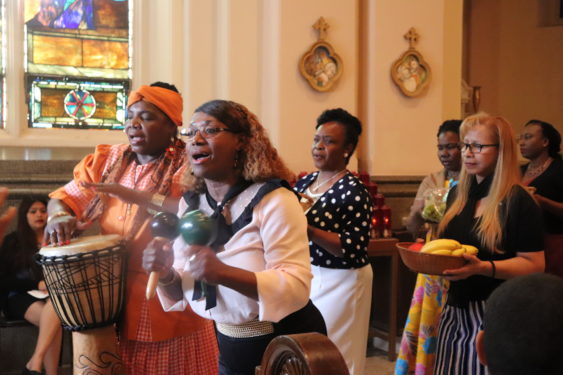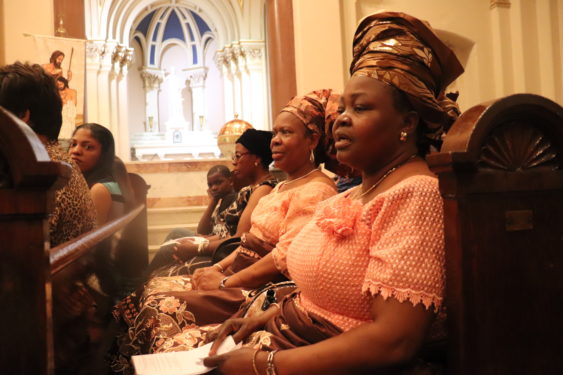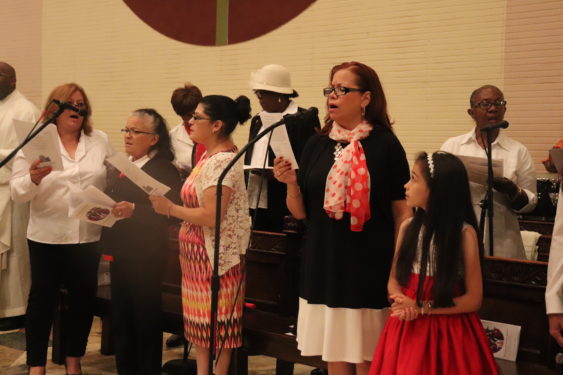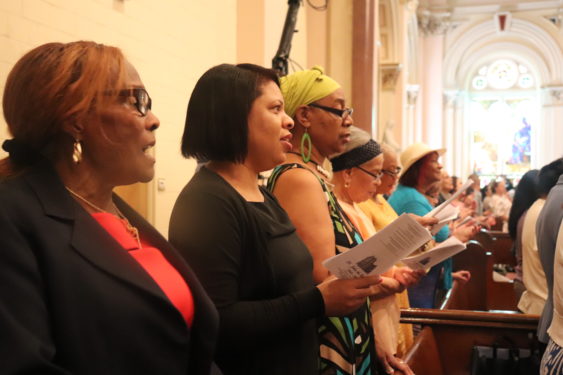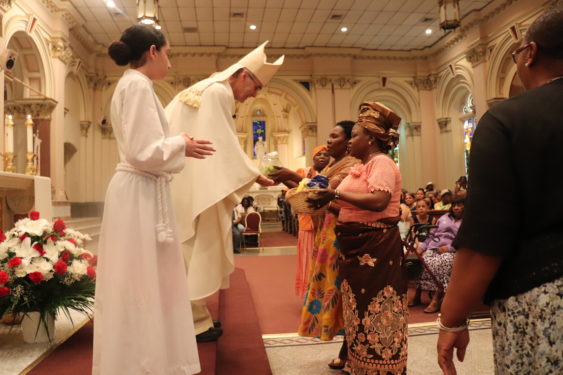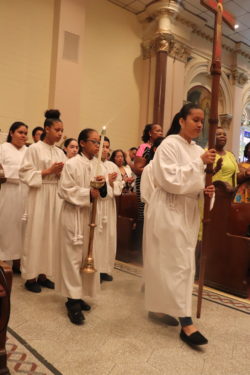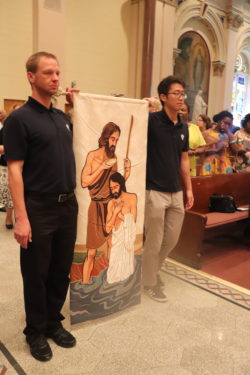St. John the Baptist Church in Bedford-Stuyvesant, founded before the construction of the Brooklyn Bridge, is the mother church of the diocesan seminary, a university and one of the city’s largest food distributing charities.
Auxiliary Bishop Paul Sanchez was the main celebrant at a jubilee feast day Mass.
“It’s a particular joy for me to be here with you on your 150th anniversary,” Bishop Sanchez said.
During his homily, he highlighted some of the parish’s impressive history, explaining that the community was the fertile ground where some of the diocese’s most essential operations were cultivated.
He honored the Vincentian Fathers who founded and continue to run the parish and the Sisters of Charity, who joined them to expand the work of the Church.
The Vincentian Fathers are also known as the Congregation of the Mission.
In 1865, Bishop John Loughlin, the first bishop of Brooklyn, asked the Vincentians to provide educational opportunities for the youth of the young diocese.
In the Spring of 1868, Vincentian Father Edward M. Smith, C.M., was sent by his superiors to Brooklyn to open a new parish, which he did by securing a block of land bound by Lewis, Stuyvesant and Willoughby avenues and Hart Street. Father Stephen V. Ryan, C.M., who would become the Bishop of Albany, secured the funds for the purchase. The land came with a little cottage. Among the first order of business was to convert one of the rooms in the cottage into a chapel.
In this small chapel on July 12, 1868, the first Mass was celebrated for the newly formed parish of Mary, Queen of the Isles, that was renamed as St. John the Baptist two years later. On the same day, Bishop Loughlin laid the cornerstone for the first church building. It would be a temporary wooden structure.
Birth of a University
The very next year, Bishop Loughlin laid the cornerstone for St. John the Baptist College, the predecessor of St. John’s University. The college was opened in 1870 serving an initial 47 students under the direction of six faculty members on Lewis Avenue in Brooklyn.
The steady influx of immigrants from Italy and Ireland necessitated the building of a larger, more permanent church.
On June 24, 1888, Bishop Loughlin laid the cornerstone for the building that The New York Times would describe as “without equal in magnificence in this part of the country.” The outside and inside was built with splendor to last for centuries. The walls were thicker than most people are tall. The building was constructed with blue granite, in the style of churches in Rome.
“The detail work on the interior of the church is the real treasure – it took another 20 years to complete after the building was opened to parishioners,” wrote Hannah McCarthy for her extensive feature on the parish for the online “Bedford and Bowery” in 2014.
“Over 150 skilled mason workers decorated the walls, alcoves and arches. Priceless religious art was lit by fifteen hundred skillfully arranged spotlights. The altar was fashioned of marble and onyx, parts inlaid with orbs of polished translucent stone and graced by life-sized trumpeting angels.”
But the construction of the massive building and the college were not the only responsibilities the parish undertook.
The major seminary for the Diocese was founded there in 1889. A grammar school was added in 1903 and a high school, St. John’s Prep, in 1927.
Until the 1920s, the church regularly filled the pews, which held 1,200 congregants for the regular 12 weekend Masses. The Great Depression hit the area hard. Economically, the neighborhood never recovered and the parish suffered. The upkeep of the magnificent structure started to become a crippling burden.
“In the mid-1950s, the ills of the neighborhood began to seep through the six-and-a-half-foot granite walls and by the 1970s, Bed-Stuy had achieved full-blown slum status – a place one of the community’s developers, Barry Stein, dismissed as ‘the largest ghetto in the country,’” McCarthy wrote.
McCarthy intended to write an article about the sad decline of St. John the Baptist and its parish community. The educational institutions founded here either no longer exist or are no longer affiliated with the parish. The congregation has been so small for so long that a smaller worship space has been built like a box inside the former worship space and the parish was merged with nearby Our Lady of Good Counsel.
Vibrant Faith Community
But the story she found was something much different. She began to understand that the true fortune of the parish was not in the building or its physical treasures but in the faith and dedication of the community when she met Father Emmet Nolan, C.M. He showed her that the parish has always put the spiritual and corporal needs of people above the well being of walls and statues, though it has tried to preserve at least some of the treasure erected to honor the glory of God.
St. John’s Bread and Life was started here to aid the hungry and is now one of the biggest emergency food distributors in the city working under the leadership of St. John’s University. Throughout the years, the parish focused on the outreach it saw as most urgent for the area.
When McCarthy visited the parish in December four years ago, she was awed by the elaborate Our Lady of Guadalupe celebration organized by and for the new wave of Mexican immigrants.
The anniversary Mass was bilingual in Spanish and English, with an accent from the Garifuna population, a people of Afro-Caribbean heritage exiled from the island nation of St. Vincent and now living mostly in Central America and in the U.S. The Garifuna at St. John the Baptist brought their own cultural aspect to the jubilee liturgy, singing a couple of the songs in their own language and bringing the symbolic fruit of the harvest during the offering, including grapes and bananas.
The standing-room-only congregation, which included many children and teens, enthusiastically followed the musical energy of the bilingual choir, clapping and singing praises to God.
The choir’s goal is to inspire, said Carlos Lazarus, director for over 30 years, who has twice tried to retire. Lazarus is a nearly lifelong member of the parish. He left a couple of times, for college and for work, but the parish keeps calling him back, literally and figuratively.
He said the gift he receives in return for his loyal service, stretches beyond this realm. The choir is a community worshipping God together, that radiates joy and enthusiasm to the larger parish community.
Youth Ministry
Neysa Tejeda, a member of the choir and a parishioner for 10 years, has three children, all school aged. Each one is part of at least one parish group. When asked how she has time to juggle so many responsibilities, she seemed taken aback.
“What is better than being in the house of God,” she said. “First is God. And after God – all comes after, and there is time for everything.”
Sonia Lugo has been a parishioner since 1968. A lot has changed during her time there. The majority of the congregation was Puerto Rican. There were more social services offered in the parish and the building retained more of its former glory. But she said one thing never changes: the palatable feeling of the presence of the Holy Spirit. She had felt it when she first walked in the church at the invitation of a priest and she continues to feel it as she reminisces in front of the old altar hidden behind a wall.
“We are not what we were, nor what we shall be,” said current pastor, Vincentian Father Astor Rodriguez, C.M., at the close of the thanksgiving Mass, emphasizing the need to trust God and His divine plan, not worrying too much about the past and the future, but being grateful for the present.
He thanked all for coming to the celebration, and especially the Sisters of Charity, whom he said have been integral in not only the parish, but also his own spiritual well-being.
“I always had a Sister of Charity to show me what it means to be good,” he said.
At the end of his remarks, he invited to the altar Kaya Francis, who was celebrating her 15th birthday. She read a prayer which began with an offering of her youth to the Lord. The congregation embraced her enthusiastically by clapping.
Although the Hispanic influence in the parish is easily seen, it is not the only immigrant tradition fostered in the parish.
“It’s important to bring our own culture so that we may share it with the One Body of Christ,” said Prudencia Lambey, a member of the Garifuna community.
Parting Gift
At the end of Mass, each family received a commemorative token to take home a little piece of the history.

